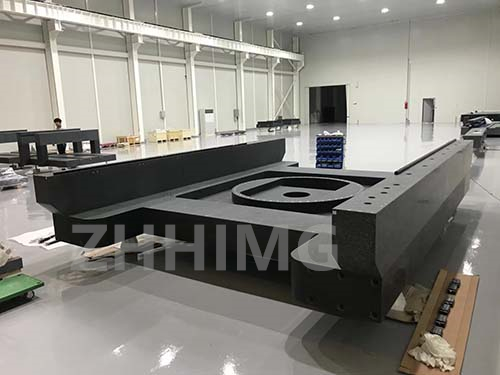In the field of semiconductor wafer inspection, the purity of the cleanroom environment is directly related to the product yield. As the precision of chip manufacturing processes continues to improve, the requirements for the carrying platforms of detection equipment are becoming increasingly strict. Granite platforms, with their characteristics of zero metal ion release and low particle pollution, have surpassed traditional stainless steel materials and become the preferred solution for wafer inspection equipment.
Granite is a natural igneous rock mainly composed of non-metallic minerals such as quartz, feldspar and mica. This characteristic gives it the advantage of zero metal ion release. In contrast, stainless steel, as an alloy of metals such as iron, chromium and nickel, is prone to electrochemical corrosion on its surface due to the erosion of water vapor and acidic or alkaline gases in a cleanroom environment, resulting in the precipitation of metal ions such as Fe²⁺ and Cr³⁺. Once these tiny ions attach to the surface of the wafer, they will change the electrical properties of the semiconductor material in subsequent processes such as photolithography and etching, cause threshold voltage drift of the transistor, and even lead to short circuits in the circuit. Professional institution test data shows that after the granite platform was continuously exposed to a simulated clean room temperature and humidity environment (23±0.5℃, 45%±5% RH) for 1000 hours, the release of metal ions was lower than the detection limit (< 0.1ppb). The defect rate of wafers caused by metal ion contamination when using stainless steel platforms can be as high as 15% to 20%.
In terms of particle contamination control, granite platforms also perform exceptionally well. Cleanrooms have extremely high requirements for the concentration of suspended particles in the air. For example, in ISO Class 1 cleanrooms, the number of 0.1μm particles allowed per cubic meter does not exceed 10. Even if the stainless steel platform has undergone polishing treatment, it may still produce metal debris or oxide scale peeling off due to external forces such as equipment vibration and personnel operation, which can interfere with the detection optical path or scratch the surface of the wafer. Granite platforms, with their dense mineral structure (density ≥2.7g/cm³) and high hardness (6-7 on the Mohs scale), are not prone to wear or breakage during long-term use. Measured measurements show that they can reduce the concentration of suspended particles in the air of the detection equipment area by more than 40% compared to stainless steel platforms, effectively maintaining the cleanroom grade standards.
In addition to its clean characteristics, the comprehensive performance of granite platforms also far exceeds that of stainless steel. In terms of thermal stability, its coefficient of thermal expansion is only (4-8) ×10⁻⁶/℃, less than half that of stainless steel (about 17×10⁻⁶/℃), which can better maintain the positioning accuracy of the detection equipment when the temperature in the clean room fluctuates. The high damping characteristic (damping ratio > 0.05) can rapidly attenuate the vibration of the equipment and prevent the detection probe from shaking. Its natural corrosion resistance enables it to remain stable even when exposed to photoresist solvents, etching gases and other chemicals without the need for additional coating protection.
At present, granite platforms are widely used in advanced wafer manufacturing plants. Data shows that after adopting the granite platform, the misjudgment rate of wafer surface particle detection has decreased by 60%, the equipment calibration cycle has been extended by three times, and the overall production cost has dropped by 25%. As the semiconductor industry moves towards higher precision, granite platforms, with their core advantages such as zero metal ion release and low particle pollution, will continue to provide stable and reliable support for wafer inspection, becoming an important force driving the progress of the industry.
Post time: May-20-2025


